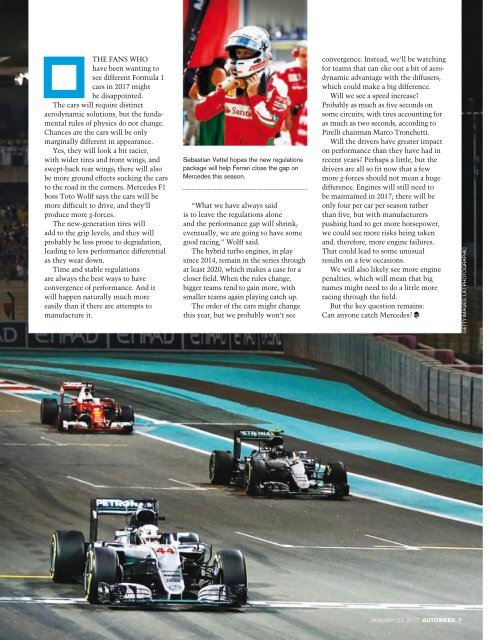Autoweek - January 23_ 2017 magazine-pdf.org
Create successful ePaper yourself
Turn your PDF publications into a flip-book with our unique Google optimized e-Paper software.
THE FANS WHO<br />
have been wanting to<br />
see different Formula 1<br />
cars in <strong>2017</strong> might<br />
be disappointed.<br />
The cars will require distinct<br />
aerodynamic solutions, but the fundamental<br />
rules of physics do not change.<br />
Chances are the cars will be only<br />
marginally different in appearance.<br />
Yes, they will look a bit racier,<br />
with wider tires and front wings, and<br />
swept-back rear wings; there will also<br />
be more ground effects sucking the cars<br />
to the road in the corners. Mercedes F1<br />
boss Toto Wolff says the cars will be<br />
more difficult to drive, and they’ll<br />
produce more g-forces.<br />
The new-generation tires will<br />
add to the grip levels, and they will<br />
probably be less prone to degradation,<br />
leading to less performance differential<br />
as they wear down.<br />
Time and stable regulations<br />
are always the best ways to have<br />
convergence of performance. And it<br />
will happen naturally much more<br />
easily than if there are attempts to<br />
manufacture it.<br />
Sebastian Vettel hopes the new regulations<br />
package will help Ferrari close the gap on<br />
Mercedes this season.<br />
“What we have always said<br />
is to leave the regulations alone<br />
and the performance gap will shrink;<br />
eventually, we are going to have some<br />
good racing,” Wolff said.<br />
The hybrid turbo engines, in play<br />
since 2014, remain in the series through<br />
at least 2020, which makes a case for a<br />
closer field. When the rules change,<br />
bigger teams tend to gain more, with<br />
smaller teams again playing catch up.<br />
The order of the cars might change<br />
this year, but we probably won’t see<br />
convergence. Instead, we’ll be watching<br />
for teams that can eke out a bit of aerodynamic<br />
advantage with the diffusers,<br />
which could make a big difference.<br />
Will we see a speed increase?<br />
Probably as much as five seconds on<br />
some circuits, with tires accounting for<br />
as much as two seconds, according to<br />
Pirelli chairman Marco Tronchetti.<br />
Will the drivers have greater impact<br />
on performance than they have had in<br />
recent years? Perhaps a little, but the<br />
drivers are all so fit now that a few<br />
more g-forces should not mean a huge<br />
difference. Engines will still need to<br />
be maintained in <strong>2017</strong>; there will be<br />
only four per car per season rather<br />
than five, but with manufacturers<br />
pushing hard to get more horsepower,<br />
we could see more risks being taken<br />
and, therefore, more engine failures.<br />
That could lead to some unusual<br />
results on a few occasions.<br />
We will also likely see more engine<br />
penalties, which will mean that big<br />
names might need to do a little more<br />
racing through the field.<br />
But the key question remains:<br />
Can anyone catch Mercedes? n<br />
GETTY IMAGES; LAT PHOTOGRAPHIC<br />
JANUARY <strong>23</strong>, <strong>2017</strong> AUTOWEEK 7


